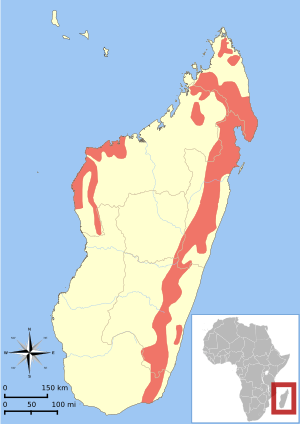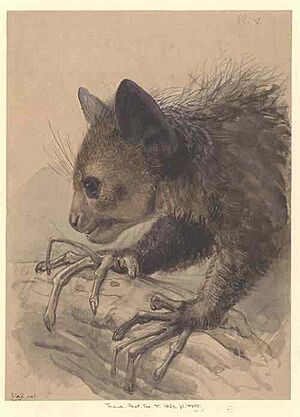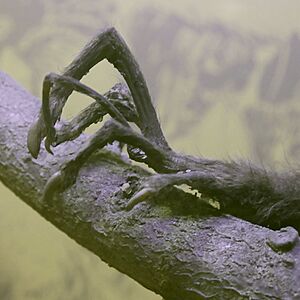Aye-aye facts for kids
Quick facts for kids Aye-aye |
|
|---|---|
 |
|
| Conservation status | |
| Scientific classification | |
| Species | |
|
|
 |
|
| D. madagascariensis distribution | |
| Synonyms | |
|
Family:
Genus:
Species:
|
The aye-aye (Daubentonia madagascariensis) is a unique type of lemur. It lives in the rain forests of Madagascar. This large island is located off the southeast coast of Africa.
Aye-ayes are nocturnal, meaning they are most active at night. They spend almost all their time in trees. During the day, an aye-aye sleeps in a cozy nest. It builds this nest from leaves and twigs in the fork of a tree.
This amazing animal has rodent-like teeth. It also has a very special thin middle finger. This finger helps it find and pull out insect grubs from under tree bark. The aye-aye acts a bit like a woodpecker. It taps on trees to find hidden grubs. Then, it uses its strong front teeth to chew holes in the wood. Finally, it uses its long middle finger to pull the grubs out.
Lemurs are a type of primate. This means they are related to monkeys, apes, and even people.
Contents
How Aye-ayes Live

The aye-aye is a nocturnal and arboreal animal. This means it lives mostly at night and high up in the trees. While they sometimes come down to the ground, aye-ayes prefer to sleep, eat, travel, and even mate in the trees. They often stay near the top of the trees. This gives them lots of cover from the thick leaves.
During the day, aye-ayes sleep in round nests. These nests are built from leaves, branches, and vines. They are usually found in the forks of tree branches. After dark, they wake up to start their hunt for food. Aye-ayes are mostly solitary animals. They mark their large home areas with their scent. The smaller areas where females live often overlap with the areas of a few males. Male aye-ayes sometimes share their territories with other males. They might even use the same nests, but not at the same time. They seem to get along until a female calls out, looking for a mate.
What Aye-ayes Eat
Aye-ayes eat many different things. Their diet includes seeds, fruits, nectar, and fungi. They also love to eat insect larvae. This makes them omnivores, meaning they eat both plants and animals.
Aye-ayes tap on tree trunks and branches very quickly. They can tap up to eight times per second! They listen to the echo to find hollow spots inside the wood. Once they find a good spot, they chew a hole into the wood. Then, they use their special narrow and bony middle fingers to pull out the grubs. Aye-ayes start looking for food about 30 minutes before sunset. They can spend up to 80% of the night searching for food in the trees. They take short breaks to rest. An aye-aye climbs trees by making quick vertical jumps, much like a squirrel. Moving sideways between trees is harder. However, aye-ayes rarely come down to the ground to jump to another tree. They can travel up to 4 km (2.5 mi) in one night.
Even though they usually look for food alone, they sometimes forage in small groups. They use sounds and scent signals to coordinate their movements within the group.
Aye-aye Social Life
People used to think aye-ayes were completely solitary. This was because they weren't seen grooming each other. But new research shows they might be more social than we thought. An aye-aye usually sticks to finding food in its own personal area. Male aye-ayes often have areas that overlap. They can be quite social with each other. Female aye-ayes, however, never have overlapping areas. But a male's area often overlaps with several females' areas. Male aye-ayes live in large spaces, up to 80 acres (32 hectares). Females have smaller living spaces, up to 20 acres (8 hectares). It's hard for males to protect just one female because their home areas are so big. This is why they often have many mates (polygyny). Aye-ayes use scent marks from their cheeks and neck. This lets others know they are there and keeps intruders away from their territory.
Like many other prosimians (a group of primates), the female aye-aye is usually stronger than the male. They don't usually have just one partner. They will often compete with each other for mates. Male aye-ayes can be very pushy. They sometimes even pull other males away from a female during mating. The aye-aye is thought to be the only primate that uses echolocation (like bats) to find its prey.
Where Aye-ayes Live
The aye-aye mostly lives on the east coast of Madagascar. Its natural home is in rainforests or deciduous forests. But many now live in areas where people grow crops. This is because their forest homes are being cut down. Aye-ayes that live in rainforests usually stay high up in the trees. They are often seen above 700 meters (2,300 feet) in altitude. They sleep during the day in nests built in the forks of trees.
Protecting Aye-ayes
People once thought the aye-aye was extinct in 1933. But it was found again in 1957. In 1966, nine aye-ayes were moved to Nosy Mangabe. This is an island near Maroantsetra off eastern Madagascar. Newer research shows that aye-ayes are found in more places than people thought. However, their conservation status was changed to endangered in 2014. This is due to four main reasons:
- Some local cultures believe the aye-aye is evil. Because of this, they are sometimes killed.
- The forests of Madagascar are shrinking due to deforestation (trees being cut down).
- Local farmers might kill aye-ayes to protect their crops.
- Aye-aye poaching (illegal hunting) is also a big problem.
- It's important to know that there's no real proof that aye-ayes harm crops. So, they are often killed because of old beliefs.
Around 50 aye-ayes can be found in zoos and animal centers around the world.
Helping Aye-ayes in Zoos
Helping this species survive has been boosted by breeding them in zoos. A key place for this is the Duke Lemur Center in Durham, North Carolina. This center has been very important in caring for, studying, and breeding aye-ayes and other lemurs. They have sent teams to Madagascar to bring lemurs back. They have created groups of lemurs that can breed in captivity. They were the first to have an aye-aye born in captivity. They studied how this baby and other young aye-ayes grew up. They have also greatly improved our understanding of what aye-ayes eat.
Interesting facts about Aye-ayes
- A full-grown aye-aye is usually about three feet (about 90 cm) long. Its tail can be as long as its body!
- Their tails can be over 9 inches (23 cm) long.
- Aye-ayes can live for more than 20 years when cared for in zoos.
- Aye-ayes are mostly solitary. This means they like to spend most of their time alone.
Images for kids
See also
 In Spanish: Aye-aye para niños
In Spanish: Aye-aye para niños






